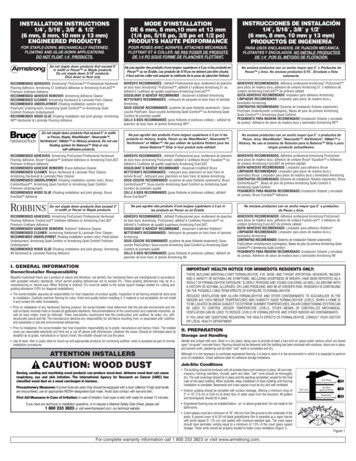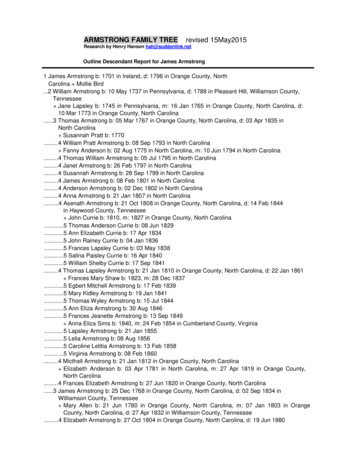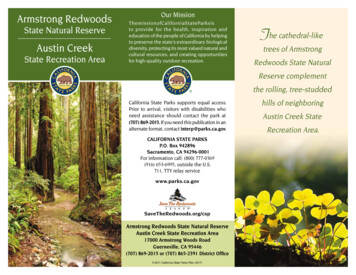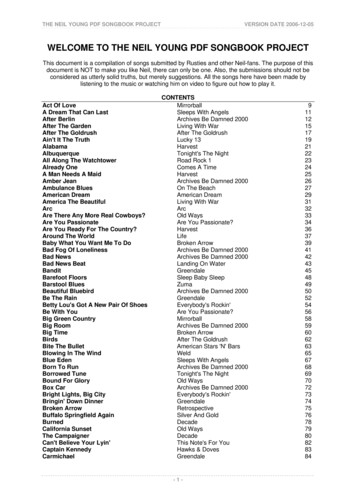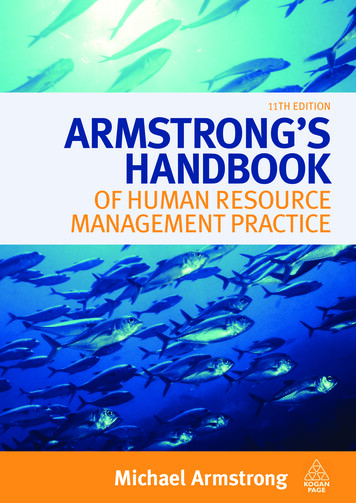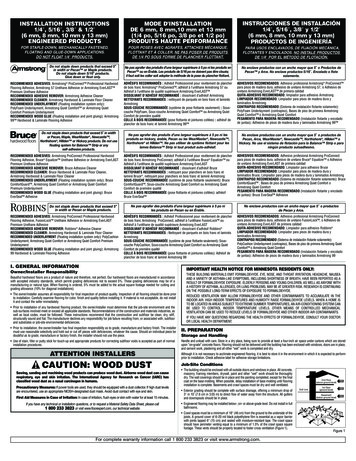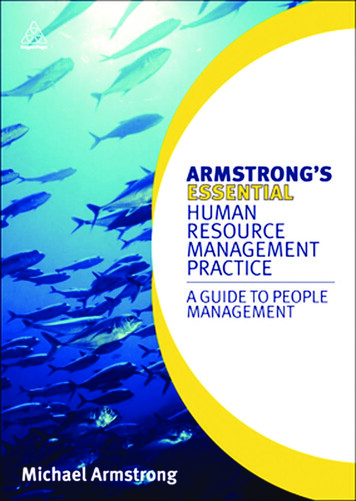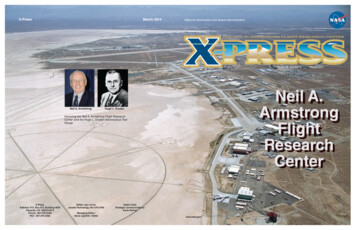
Transcription
X-PressMarch 2014National Aeronautics and Space AdministrationVolume 56 Number 2Neil A. ArmstrongNeilNeil CenterCenterHugh L. DrydenHonoring the Neil A. Armstrong Flight ResearchCenter and the Hugh L. Dryden Aeronautical TestRangeX-PressAddress: P.O. Box 273, Building 4839Edwards, CA 93523-0273Phone: 661-276-3449FAX: 661-276-3566Editor: Jay LevineJacobs Technology, 661-276-3459Managing Editor:Steve Lighthill, NASAMarch 2014NASA Chief,Strategic Communications:Kevin Rohrerwww.nasa.gov/
X-PressIndexArmstrong: From Wapakoneta,Ohio, to the moon, 4Flying a big part of Armstrong’slife, 5Dryden: Separating the realfrom the imagined, 6Reaction Control System, 8Apollo 11: First steps on themoon, 10Dyna-Soar, 12The Range, 14Range support detailed, 16Center name changes notuncommon, 17Digital Fly By Wire, 18Cover photoCenter overview byCarla Thomas,ED01-0264-14March 2014March 20143It’s a time of change,but not of our vision,mission or valuesNow is a time for change. It also is an opportunity to recommit to our existing vision, mission andvalues.President Barack Obama signed congressional resolution H.R. 667 Jan. 16 changing the name ofthe Hugh L. Dryden Flight Research Center to the Neil A. Armstrong Flight Research Center. Thischange is an immense honor for our center. Neil Armstrong was the first man to stand on the moon –he was also an engineer and a research test pilot at this center.While we are changing our name, we will continue to celebrate Dryden’s legacy. The center’sWestern Aeronautical Test Range will be renamed in his honor. Dryden was the director of theNational Advisory Committee for Aeronautics from 1949 to 1958 and the first deputy administratorfor NASA until his death in 1965.Dryden, when asked about the value of flight research with respect to the X-15 program, statedthat the purpose is, “to separate the real from the imagined and make known the overlooked andunexpected.” To that end, our vision will remain – to separate the real from the imagined throughflight. And our mission will remain – advancing technology and science through flight.We will recommit to our core values of safety, excellence, teamwork and integrity in all that we do.Throughout our history with the NACA and NASA, our ties to the agency and our sources offunding have changed and evolved over time. But regardless of the changes the work that we do hasremained constant as we fulfill a national need with our capabilities and competencies. Our roleremains in the integration of complex flight systems and their safe test and flight operations.Though we have diversified from our core aeronautics base, the work we continue to do in scienceand space exploration utilizes our ability to understand problems and the connection to flight, tounderstand the vehicle and to safely clear the flight envelope.As of March 1, we are working on the transition for the name changes to celebrate these two greatmen.We, as the Dryden – and now the Armstrong – team, have the ability to make complex flightsystems work safely. That will not change.David McBrideNeil A. Armstrong Flight Research Center directorED14-0049-58NASA/Tom TschidaArmstrong Director David McBridetalks to U.S. Rep. Kevin McCarthyat the Antelope Valley Board ofTrade Outlook Conference. It wasannounced at the conference whenthe name changes would be official.The background photo of administrative Building 4800 and the X-1Eresearch aircraft is by Carla Thomas,ED07-0296-14.ED14-0049-58NASA/Tom Tschida
X-PressMarch 2014March 2014Flying a big partArmstrong’s lifeArmstrongPeter MerlinArmstrong Public AffairsFrom Wapakoneta, Ohio, to the moonNeil A. Armstrong, the firstman to walk on the moon, wasborn in Wapakoneta, Ohio,on Aug. 5, 1930. He began hisNASA career in Ohio.After serving as a naval aviatorfrom 1949 to 1952, Armstrongjoined the National AdvisoryCommittee for Aeronautics,or NACA, in 1955. His firstassignment was with theNACA Lewis Flight PropulsionLaboratory (now NASA GlennResearch Center) in Cleveland.For the next two decades, he wasan engineer, test pilot, astronautand administrator for the NACAand its successor agency, theNational Aeronautics and SpaceAdministration.As a research pilot at theNACA High Speed FlightStation – now renamed in hishonor – he was a project piloton many pioneering high-speedaircraft, including the X-15rocket plane. During his life heflew more than 200 differentmodels of aircraft, includingjets, rockets, helicopters andgliders.Armstrongjoinedtheastronaut corps in 1962. He wasassigned as command pilot forthe Gemini 8 mission. Gemini8 was launched on March 16,1966, and Armstrong performedthe first docking of two vehiclesin space.As spacecraft commander forApollo 11, the first manned lunarlanding mission, Armstrongbecame the first man to land acraft on the moon and first toNASABefore he was accepted as an astronaut and went to the moon, Armstrongwas a research pilot here. One of the aircraft he flew was the rocket-poweredX-15 research vehicle. He is seen climbing the stairs to enter the X-15 fora flight.step on its surface.Armstrong subsequently heldthe position of deputy associateadministrator for aeronauticsat NASA headquarters inWashington, D.C. In thatposition, he was responsiblefor the coordination andmanagement of overall NASAresearch and technology workrelated to aeronautics.He was a professor of aerospaceengineering at the University ofCincinnati in Ohio between 1971and 1979. Between 1982 and1992, Armstrong was chairmanof Computing Technologies forAviation Inc., Charlottesville, Va.He received an aeronauticalengineering degree from PurdueUniversity and an aerospaceengineering master’s degreefrom the University of SouthernCalifornia. He held honorarydoctorates from a number ofuniversities.Armstrong was a fellow of theSociety of Experimental TestPilots and the Royal AeronauticalSociety; honorary fellow ofthe American Institute ofAeronautics and Astronautics andthe International AstronauticsFederation.He was a member ofthe National Academy ofEngineering and the Academyof the Kingdom of Morocco.He served as a member ofthe National Commission onSpace from 1985-1986, as vicechairman of the PresidentialCommission on the SpaceShuttle Challenger Accident5NASANeil Armstrong is pictured at his desk in the pilots’ office in 1960.NASANeil Armstrong, from left, Joe Engle and Bill Dana pose in front of aRobert McCall painting at the center. Armstrong and Engle were here tohonor Dana, who in 2005 received his astronaut wings for reaching theedge of space in the rocket-powered X-15.in 1986 and as chairman ofthe Presidential AdvisoryCommittee for the PeaceCorps from 1971-1973.Seventeencountriesdecorated Armstrong. Hisspecial honors included thePresidential Medal of Freedom;the Congressional Gold Medal;theCongressionalSpaceMedal of Honor; the ExplorersClub Medal; the Robert H.Goddard Memorial Trophy;the NASA DistinguishedService Medal; the HarmonInternational Aviation Trophy;the Royal Geographic Society’sGold Medal; the FederationAeronautique Internationale’sGold Space Medal; theAmericanAstronauticalSociety Flight AchievementAward; the Robert J. CollierTrophy; the AIAA AstronauticsAward; the Octave ChanuteAward and the John J.Montgomery Award.Armstrong passed awayon Aug. 25, 2012, followingcomplications resulting fromcardiovascular procedures. Hewas 82.When Neil Armstrong joinedthe National Advisory Committeefor Aeronautics (NACA), NASA’spredecessor, in 1955, he was alreadyan accomplished aviator. Armstrongwas fascinated with aviation froman early age, experiencing flight forthe first time at age 5, when he wastaken for a ride in a Ford Tri-Motor.At 15 he was taking flying lessonsat a small airport near his home inWapakoneta, Ohio, and obtained hisprivate pilot’s license at 16.While studying aeronauticalengineering at Purdue University ona Naval scholarship, Armstrong wascalled to active duty by the Navy in1949, earning his wings flying jets.He deployed to Korea with a navalfighter squadron in 1951 and flew78 combat missions in an F9F-2Panther from the U.S.S. Essex.Armstrong joined the NACA atwhat was then known as the LewisFlight Propulsion Laboratory (nowthe NASA Glenn Research Center)upon his discharge from the Navy.A few months later, he transferredto the NACA’s High-Speed FlightStation at Edwards Air Force Base,serving as an aeronautical researchscientist and then as a test pilot atthe facility that would one day bearhis name, before joining the NASAastronaut corps in 1962.While at the station, which wasrenamed the Flight Research Centerin 1959, Armstrong flew 48 differentexperimental research, flight testand mission support aircraft. Heperformed stability and controlresearch, flew chase and supportmissions, and developed a techniquefor surviving a launch mishap in anexperimental space plane. He flew awide variety of conventional aircraft,but he is better known for his sevenresearch missions in the rocketpowered X-15, reaching speeds inexcess of Mach 5 and altitudes above207,000 feet. He eventually amassedmore than 2,450 flight hoursduring his seven years at the center,part of the more than 6,000 hourshe recorded in piloting more than200 aircraft.After joining the astronaut corpsat the Manned Spacecraft Center(now NASA’s Johnson SpaceCenter) in Houston, Armstrongflew the Northrop T-38A Talon andthe Bell Aerosystems Lunar LandingTraining Vehicle. Following hisNASA career he continued to flynumerous aircraft from sailplanesto the supersonic B-1B bomber. In1979 he participated in five recordsetting flights in a Gates Learjet.With the NACA and NASA atEdwards, he flew the followingtypes of aircraft:Experimental Research Aircraft– Bell X-5, Bell X-1B, NorthAmerican Aviation X-15, NASAParaglider Research Vehicle(Parasev), Lockheed NT-33AVariable Stability Trainer, ConvairNC-131B Flying SimulatorFighters – Convair F-102,Convair F-106, Douglas F5D-1,Lockheed F-104, North AmericanAviation F-86D, North AmericanAviation F-100, McDonnell F-4,McDonnell F-101, RepublicF-105, North American AviationF-51.Bombers – Boeing B-47, BoeingB-29Trainers – Cessna T-37, LockheedT-33Transports – Douglas C-47,Beechcraft C-45, Boeing KC-135General Aviation – Cessna L-19Bird Dog, Piper PA-23 Apache,Lockheed JetStarHelicopters – Hiller H-23,Piasecki H-21
X-PressMarch 2014DrydenSeparating the real from the imaginedBy Christian GelzerArmstrong historianThe Hugh L. Dryden AeronauticalTest Range is named for a manwho was one of America’s mostprominent aeronautical engineers.Dryden was a driving force foraeronautics, the National AdvisoryCommittee for Aeronautics, orNACA, NASA and the agency’splan to go to the moon.Of significance to Neil A.Armstrong Flight Research Centeremployees, during Dryden’s careerhe approved of the establishmentof a permanent aeronautics centerhere.From an early age it was clearthat Dryden was extraordinary. Heentered Johns Hopkins Universitywhen he was 14, graduated withhonors three years later and earneda master’s degree in physics at theage of 17. He took a job at theNational Bureau of Standards,or NBS, then one of only threefederally funded research agenciesin the U. S. Dryden continuedtaking additional graduate coursesat Johns Hopkins in fluid dynamicsand earned his doctorate in appliedphysics at 20 years old in 1919to become one of the youngeststudents to ever to receive such adegree from that institution.Dryden soon became head of theAerodynamics division of the NBSwhere “he and [Dr. Lyman] Briggsobtained the first U.S. wind-tunneldata showing lift and drag forairfoils above the speed of sound,”wrote former center historianMichael Gorn. It helped establishthe young man’s reputation in thefield, but it also portended hisleadership as well, he added. SomeNACAHugh L. Dryden was a key figure in Aeronautics research and a driving forcebehind the National Advisory Committee for Aeronautics, or NACA, NASAand the plans for the moon mission. This image shows Dryden when he wasserving as director of the NACA.of Dryden’s work in the mid-1920sinvestigated airfoil characteristicsat air speeds at and just beyondthe speed of sound. Dryden alsois credited with coining the wordtransonic to describe airflow atspeeds approaching Mach 1, orabout 600 to 761 mph dependingon altitude, temperature andatmospheric conditions. The fastestaircraft then flying could reach lessthan 300 mph. His data was usedby the NACA and contributed todevelopment of the laminar flowwings used on the famed P-51Mustang fighter of World War II.By 1934 Dryden was namedchief of the Mechanics and SoundDivision of the NBS, whichincluded his own AerodynamicsSection. In 1935 he was one of threeAmericans invited to participate inthe Fifth Volta Congress in Rome.Eastman Jacobs, of the NACA’sLangley Aeronautical MemorialLaboratory, and Theodore vonKármán were the other two.The Volta Congresses gatheredextraordinarymindsforpresentations and discussions. Thefifth congress focused on highspeeds in Aviation and drew 38of the world’s greatest minds inthe field, including Jacob Ackert,Ludwig Prandtl, Geoffrey IngramTaylor and Adolf Busemann.In 1938 Dryden was invited topresent the Wilbur Wright Lectureat the Institute of AeronauticalSciences. He read, “Turbulence andthe Boundary Layer,” a summary ofthe research to that point, includinghis own work. The onset of WorldWar II brought Dryden newresponsibilities in both researchand leadership and he eventuallyled the Navy’s Bureau of OrdinanceExperimental Unit. There, hisgroup successfully developed theBat, an aircraft-launched gravitybomb capable of self-correctionin flight, or a guided missile. TheBat was the only American guidedmissile used in combat duringthe war, which was credited withsinking several enemy vessels.Starting in late 1945 Dryden joinedvon Kármán in Europe where, nowwearing military uniforms, theywere part of advance teams visitingrecently uncovered flight researchlaboratories. For his meticulousand laborious work documentingtheir discoveries, Dryden wasawarded the National Medal ofFreedom.March 2014In 1946 Dryden becameassistant director of the Navy’sordinance bureau, followed in sixmonths by his appointment asassociate director. Within anothersix months, he was selected tosucceed George W. Lewis as theNACA’s director of aeronauticalresearch. The former Lewis FlightPropulsion Laboratory was namedfor him and the NASA facility isnow called the Glenn ResearchCenter.By 1949 Dryden had becomethe first person to hold the newposition of director of the NACA.Then, the NACA had about 6,000personnel in major facilities at theAmes, Lewis, and Langley researchlaboratories, at Wallops Island, Va.,and at what was then the HighSpeed Flight Research Station atMuroc, Calif., now known as theArmstrong Flight Research Center.Gorn described Dryden as,“perhaps the most influentialcivilian figure in American flightresearch,” a characterization thatheld fast until the end of his life.From the start of his tenure hesaw the need for – and followedthrough on the delivery of –new facilities for supersonic andhypersonic as well as high altituderesearch and the participation insuch research with a raft of newand exotic aircraft.Many of the aircraft were flownfrom the flight research center thatshared Dryden’s name for morethan 30 years. One of the mostfamous of these aircraft was theNorth American Aviation X-15.An air-launched rocket planedesigned to reach 200,000 feetand hypersonic speeds, the threeX-15A research vehicles eventuallyreached Mach 6.7 and 354,200feet. It became the first vehicle toexit Earth’s atmosphere, fly backto a landing, and fly back againto space during the flight researchprogram from 1959 through 1968.During a preliminary review ofthat program in 1956, Drydenlaid out the X-15’s purpose: “ toseparate the real from the imaginedproblems [of hypersonic flight]and to make known the overlookedand the unexpected problems.”7NACANACA Director Hugh L. Dryden presented the NACA Exceptional Service Medal to the flight and ground crew of theX-1A rocket plane research project at the NACA High Speed Flight Station on Nov. 26, 1956. From left are Dryden,X-1A research pilot Joe Walker, B-29 mothership pilot Stan Butchart and X-1A crew chief Richard Payne.The launch of Sputnik alarmedneither Dryden nor his immediatecolleagues. This may not havebeen to his benefit in the end,however, at a time when hysteriaswept the nation. That wasparticularly true with the launchof Sputnik II barely a month afterthe first satellite went up. Manylooked for someone to blame:Dryden seemed an ideal culprit.It did not help that he remainedunflappable in the face of all this;so did President Eisenhower, butthe blame could be more easilyfixed on Dryden. The presidentonly reluctantly gave intopressure from a host of specialinterests for some visible reactionto the Sputniks, and signedlegislation creating a new agencyto lead the nation’s response, theNational Aeronautics and SpaceAdministration. NASA unfoldedfrom the NACA in October 1958.AlthoughDrydenwasinstrumental in its creation,and should be credited as oneof the forces ensuring it be acivilian agency that emerged, hisassociation with the NACA wasmore than Congress could acceptwhen it came to selection of thenew administrator. That job wentto T. Keith Glennan, then presidentof Case Institute of Technology –who accepted the job only on thecondition that Dryden would behis deputy. Despite relegation toa less prominent position, Drydenremained unwavering in supportfor both aeronautics and space andunderstood well the importancethat going to the moon and backrepresented, even when othersaround him saw it with less vision.Dryden said in the early 1960s:“It is important to realize that thereal values and purposes are notin the mere accomplishment ofa man setting foot on the moon,but rather in the great cooperativenational effort in the developmentof science and technology whichis stimulated by this goal. Thisnational enterprise is an activityof critical impact on the future ofthis nation as an industrial andmilitary power and as a leader ofthe free world.”Dryden became NASA’s reveredelder statesman of science andshared with the administrator themanagement of a multi-billiondollar program to develop spacevehicles, advance space-relatedsciences, enable humans to travelout to the moon and back andcarry out extensive aeronauticalresearch. Dryden also served aschief U.S. negotiator for earlyhistoric agreements with theSoviet Union on the peaceful useof space.Dryden succumbed to illness inDecember 1965. President LyndonJohnson, long an admirer of Dryden,stated publicly: “Whenever the firstAmerican space man sets foot onthe moon or finds a new trail to anew star, he will know that HughDryden was one of those who gavehim knowledge and illumination.”The center once named for Drydennow is named for Neil Armstrong,the first human to set foot on themoon and an immediate benefactorof much of Dryden’s knowledgein aeronautics, hypersonics andspaceflight.
X-PressMarch 2014ReactionControlSystemKeeping control of anaircraft at the edge ofspace required newthinking – enter theHSFS engineering staffNACANeil A. Armstrong pilots the Iron Cross simulator in 1956.By Curtis PeeblesSpecial to the X-PressReaction control systems used on the X-15, the space shuttles andmost spacecraft and satellites have their roots in the Mojave Desert.Reaction control systems allow maneuvering in space and low-Earthorbit.A group of National Advisory Committee for Aeronautics engineersat the High Speed Flight Station, now known as the Armstrong FlightResearch Center, had an idea in 1956 to control an aircraft at the edgeof space.In order to begin investigating the advanced concept, Richard Engineers gather in 1956 to see a Iron Cross simulation.Day, Joe Weil, Donald Reisert, Wendell Stillwell and several otherNACA engineers at the HSFS knew they would need a sophisticatedcomputer to power a flight simulator. The engineers convinced theAir Force to acquire and maintain a Goodyear Electronic DifferentialAnalyzer, or GEDA, analog computer on base and allow them to useit.Day and Weil developed the simulator that featured the world’s firstreaction control system. RCS consisted of small thrusters that fired tostabilize or redirect a vehicle in a vacuum. At that time no human hadleft the atmosphere. But the X-15 was on the way and the engineersknew that at its planned peak altitude – expected to be 200,000 feet (iteventually reached 354,200 feet) – there would be such low dynamicpressure that it would effectively be in space. Reaction controls weregoing to be essential. All this was new – what to use for fuel, howmuch thrust was needed, what were the effects of system lag, what wasthe control effectiveness and even how the control stick would work.With NACA pilots in the loop, the engineers ran simulations of theBell X-1B on the GEDA to see how it might look.Satisfied with the initial tests, the engineers saw to the construc- The X-1B reaction control system thrusters are tested in 1958.NACANACAMarch 2014tion of the Iron Cross simulator late in 1956, two long steel I-beamsbalanced on a universal joint and ballasted to the same inertial ratiosas the X-1B. The center of gravity was at the pivot point while the“cockpit” was located a similar distance from the center of gravity asthe X-1B’s cockpit. The pilot’s seat was perched on the I-beam.The pilot had a heading indicator, an artificial horizon and a sideslipindicator. Control came from nitrogen jets mounted in opposing pairs:two pointing up and down (for pitch control), two more pointingright and left (for yaw control) – all on the rear arm of the Iron Cross;two roll jets, pointing up and down, mounted on the right arm. At theend of each arm was a crash bar, a steel strip with a skid at its end tokeep the Iron Cross from pranging on the hangar floor.Stan Butchart and the other High Speed Flight Station pilots began flying the Iron Cross, among them a relatively new member tothe pilot’s group, Neil A. Armstrong. In time the engineers had analuminum box added to the cockpit, eliminating visual cues so thepilots could only fly on instruments. But if they were to go beyond thetheoretical they would have to put their idea onto an airplane.They selected the Bell X-1B, a second-generation design that usedthe same wing, horizontal tail and XLR11 rocket engine as the firstgeneration X-1 rocket plane, but with a fuselage just over four-and-ahalf feet longer (the maximum length that would still fit in the bombbay of the B-29 launch aircraft). Work on the X-1B’s RCS installationbegan in February 1957, which had to be shoehorned into the aircraftsince it wasn’t part of the initial design. A single pair of roll thrusterswas mounted in the left wingtip; the yaw thrusters were in the rearfuselage, placed ahead of the tail assembly. Pitch thrusters were oddlylocated: one under the forward fuselage, the other just above the rocket nozzle. The thrusters were powered by 90 percent concentrated hydrogen peroxide, forced over silver-coated stainless steel screens. Thehydrogen peroxide decomposed into 1,300 degree Fahrenheit steamthat blasted out the nozzle to produce thrust.By July 1957, preparations were underway to begin the RCS research flights; at this point Armstrong joined Butchart as pilot on theresearch project. Armstrong transferred to the HSFS from the NACA’s Lewis facility (now Glenn) in 1955 and over the next two yearsflew a wide range of aircraft at the facility. He had been flying the F-51chase plane when the X-1A exploded, had been the co-pilot on theP2B-1S launch aircraft on March 22, 1956, when engine number 4lost a propeller that then took out engines numbers three and two inthe process, but Armstrong had not yet flown a rocket plane.Armstrong made his first X-1B flight on Aug. 15, 1957, duringwhich the number two rocket chamber failed to light after the aircraftwas released from the launch aircraft. Despite this, he reached a speedof Mach 1.32 at an altitude of 45,000 feet on the remaining threecylinders.Armstrong’s next tests of the RCS came early in January 1958. Butthere were problems getting pressure readings from either the hydrogen peroxide tank or the RCS itself. In the X-1B cockpit, nestled inthe bomb bay at some 25,000 feet, he fired the thrusters. Observersinside the B-29 and in the chase plane confirmed they worked, andso the crew decided to continue the mission but to launch closer toRogers lakebed; that way, if Armstrong was unable to start the rocketengines he could glide to a lakebed landing.On Jan. 16 the release was made directly over the intended landing area and Armstrong successfully ignited the XLR11. During theclimb he fired each of the six RCS thrusters in turn for one second.Reaching 45,000 feet, he began the pushover to level flight, flew arelatively low-altitude/low Mach profile, shut down two of the four9NACAThe Iron Cross simulator was encased to eliminate a pilot’s visual cues in orderto focus on the instrumentation.chambers, then a third soon after, followed by a complete set of RCSfirings. After shutting down the final chamber Armstrong again firedall the RCS rockets. He noted that although the X-1B was flying at arelatively high dynamic pressure during all of the thruster firings, RCSeffectiveness was pronounced. He made a successful deadstick landingon the lakebed.The resumption of the X-1B RCS flights was originally scheduled forMay 28, but a preflight inspection of the aircraft found four cracks in thebottom of the liquid oxygen, or LOX, tank. These were welded closed.X-rays of the LOX tank were taken on June 4, and when they were examined, internal cracks were found again. It was time to park the airplanepermanently and find another platform to continue testing RCS.The choice was the F-104A, which soon became the JF-104A in recognition of its temporary modification. Chief pilot Joe Walker made thefirst RCS flight on July 31, 1959, taking it to an altitude of 30,000 feet,a speed of Mach 0.8. By the time the JF-104 flights were drawing to aclose, the X-15 was beginning its early research flights. The relationshipbetween the data collected from the JF-104 RCS flights and the finaldesign of the X-15’s RCS was clear: the latter had eight yaw and pitchthrusters located on the nose while two roll thrusters were positionednear each wing tip.Because a failure of the RCS at high altitude would lead to the loss ofthe X-15, the thrusters were divided into two separate, redundant systems. During the JF-104 flights, a reaction augmentation system (RAS)was tested to increase the stability of the aircraft at low dynamic pressure.North American Aviation, the X-15’s builder, proposed an RAS be addedto the aircraft: Armstrong and Walker flew a simulation of the RCS andagreed that it made the simulation easier to fly. In 1963 an RAS wasadded to X-15s numbers one and two. By this time, human spaceflighthad become a reality and RCS was an essential part of every space-boundvehicle.Armstrong was an integral member of the team that developed RCSfrom the Iron Cross onward. “If I have seen further,” said Isaac Newton,“it is by standing on the shoulders of giants.” Those who travel safely inspace do so on the shoulders of people like Butchart, Day, Weil, Reisert,Stillwell, Walker and Armstrong.
X-PressMarch 2014March 201411Apollo 11First steps on the moonApollo 11 astronauts NeilArmstrong, Buzz Aldrin andMichael Collins sat atop a SaturnV at the Kennedy Space Centeron July 16, 1969. The three-stage363-foot tall rocket with 7.5million pounds of thrust was usedto propel the astronauts into spaceand into history.The engines fired and Apollo11 cleared the tower. About 12minutes later, the crew was inEarth orbit.After 1½ orbits, Apollo 11received the green light to head forthe moon. Three days later the crewwas in lunar orbit. A day after that,Armstrong and Aldrin climbedinto the lunar module Eagle andbegan the descent, while Collinsorbited in the command moduleColumbia.When it came time to land Eaglein the Sea of Tranquility, Armstrongimprovised, manually pilotingthe ship past an area littered withboulders. During the final secondsof descent, Eagle’s computer wassounding alarms.The computer was fine – justchallenged by the big workload.Aldrin noted, “Unfortunately itcame up when we did not want tobe trying to solve these particularproblems.”When the lunar module landed,only 30 seconds of fuel remained.Armstrong radioed, “Houston,Tranquility Base here. The Eagle haslanded.” Mission control eruptedin celebration as the tension brokeand a controller told the crew, “Yougot a bunch of guys about to turnblue, we’re breathing again.”NASAAbove, Apollo 11 Commander Neil Armstrong works at an equipment storage area on the lunarmodule. This is one of the few photos that show Armstrong during the moonwalk. Below, Armstrongis in the lunar module following his historic moonwalk.NASACrater 308 stands out in this photo from lunar orbit.Armstrong later confirmed thatlanding was his biggest concern,saying, “the unknowns wererampant,” and “there were just athousand things to worry about.”Once on the moon, Armstrongwas ready to make the first humanfootprint on another world. Morethan half a billion people watchedon television as Armstrong climbeddown the ladder and proclaimed:“That’s one small step for a man,one giant leap for mankind.”Aldrin joined him and offereda simple but powerful descriptionof the lunar surface: “magnificentNASAAbove, Buzz Aldrin poses for a portrait taken byNeil Armstrong, who can be seen reflected on thevisor. At left, Smoke and flames signal the openingof a historic journey as the Saturn V clears thelaunch pad. Below, is Aldrin’s footprint on themoon.desolation.” They explored thesurface for 2½ hours, collectedsamples and took photographs.They left behind an Americanflag, a patch honoring the fallenApollo 1 crew and a plaque on oneof Eagle’s legs. On the plaque is,“Here men from the planet Earthfirs
From Wapakoneta, Ohio, to the moon Armstrong Neil A. Armstrong, the first man to walk on the moon, was born in Wapakoneta, Ohio, on Aug. 5, 1930. He began his NASA career in Ohio. After serving as a naval aviator from 1949 to 1952, Armstrong joined the National Advisory Committee for Aeronautics, or NACA, in 1955. His first assignment was with the
